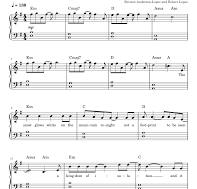Exploring the Piano Notes of “Let It Go”
“Let It Go” from Disney’s animated film Frozen has captured the hearts of audiences worldwide with its powerful message and beautiful music. For piano enthusiasts looking to play this iconic song, understanding the piano notes is essential.
The Introductory Melody
The opening notes of “Let It Go” set the tone for the entire piece. The melody begins with a sequence of E – E – D – C – D – E – D, creating a sense of anticipation and magic. As you progress through the song, pay attention to the dynamics and phrasing to convey the emotions behind each note.
The Chorus: Embracing Empowerment
When you reach the chorus of “Let It Go,” embrace the sense of empowerment and freedom that Elsa experiences in the film. The notes in this section, such as G – F – G – A, reflect Elsa’s journey towards self-acceptance and independence.
Mastering Technique and Expression
To truly bring “Let It Go” to life on the piano, focus on mastering both technique and expression. Experiment with different tempos, dynamics, and articulations to infuse your performance with emotion and depth. Remember that each note carries a story, so play with intention and sensitivity.
Conclusion
“Let It Go” is not just a song; it’s a musical journey that invites pianists to explore themes of self-discovery and resilience. By delving into the piano notes of this beloved piece, you can unlock new levels of creativity and artistry in your playing.
Mastering ‘Let It Go’ on Piano: 6 Essential Tips for Perfecting Your Performance
- Practice playing the right hand melody separately to get familiar with the notes.
- Focus on playing the left hand chords smoothly and in rhythm.
- Pay attention to dynamics, such as crescendos and decrescendos, for expression in your performance.
- Use pedal technique to sustain notes where needed for a more connected sound.
- Take it slow at first to master each section before trying to play at full speed.
- Listen to recordings of the song to understand how it should sound and interpret it in your own style.
Practice playing the right hand melody separately to get familiar with the notes.
To enhance your proficiency in playing “Let It Go” on the piano, a valuable tip is to practice the right hand melody independently. By isolating the melody and focusing solely on the notes played by the right hand, you can familiarize yourself with the intricacies of the tune. This approach allows you to develop a deeper understanding of the melody’s structure and helps build muscle memory, ultimately leading to a more confident and polished performance when combined with the left hand accompaniment.
Focus on playing the left hand chords smoothly and in rhythm.
When approaching the piano notes of “Let It Go,” a crucial tip is to prioritize playing the left hand chords smoothly and in rhythm. The left hand provides the harmonic foundation of the piece, supporting the melody played by the right hand. By focusing on maintaining a steady rhythm and ensuring that the chords transition seamlessly from one to the next, pianists can create a solid musical framework that enhances the overall performance. Paying attention to the left hand’s dynamics and timing will not only improve the cohesiveness of the piece but also elevate its emotional impact, adding depth and richness to each chord progression.
Pay attention to dynamics, such as crescendos and decrescendos, for expression in your performance.
To truly capture the essence of “Let It Go” in your piano performance, it is crucial to pay attention to dynamics, including crescendos and decrescendos. By incorporating these dynamic elements into your playing, you can add depth and emotion to your interpretation of the song. Gradually building up the volume during crescendos and gently decreasing it during decrescendos allows you to convey the powerful emotions and nuances of Elsa’s journey in a way that resonates with listeners. Mastering these dynamic changes will elevate your performance and bring out the true beauty of the music.
Use pedal technique to sustain notes where needed for a more connected sound.
To enhance the rendition of “Let It Go” on the piano, incorporating pedal technique is crucial for sustaining notes at key moments, thus creating a more connected and harmonious sound. By skillfully applying the pedal where needed, pianists can achieve a seamless transition between notes, allowing for a smoother and more resonant performance. This technique not only adds depth and richness to the music but also helps to maintain the emotional intensity of the piece, captivating listeners with its immersive and cohesive sound.
Take it slow at first to master each section before trying to play at full speed.
When learning the piano notes for “Let It Go,” it is crucial to take a gradual approach to mastery. Begin by practicing each section slowly and methodically, focusing on accuracy and technique. By mastering each segment at a comfortable pace, you can build a strong foundation and deepen your understanding of the piece. Only after gaining confidence in playing each section should you gradually increase the tempo, ensuring a polished and confident performance when playing at full speed.
Listen to recordings of the song to understand how it should sound and interpret it in your own style.
Listening to recordings of “Let It Go” is a valuable tip for pianists aiming to master the piece. By immersing yourself in different interpretations of the song, you can gain a deeper understanding of its nuances and emotions. Paying attention to how various musicians approach the melody, dynamics, and phrasing can inspire you to develop your unique style and interpretation. Embrace the opportunity to blend elements from different performances while staying true to your artistic vision, allowing you to infuse your rendition of “Let It Go” with authenticity and creativity.

